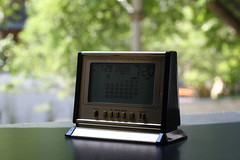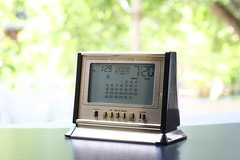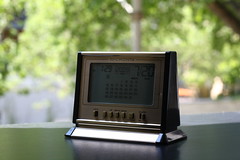
 Photography Notebook:
Metering Mode
Photography Notebook:
Metering Mode
Whenever you take a photo, the camera's programming measures the scene's light values and uses an algorithm to interpret the light on the camera's sensor. How this interpretation is done depends on all the camera's settings, including the metering mode set for the camera. The metering mode sets a pattern for how different areas of the scene are exposed in making a photo. In the Rebel, you can choose from among four metering modes--evaluative, partial, spot, and center-weighted average. You can choose from among these modes in the Av, Tv, P, or M shooting modes. These choices give you a chance to set how the camera interprets a scene's light values for different areas of the photo. The metering mode is something that you might not be adjusting with each photo, and you could even leave the camera on evaluative metering most of the time, but knowing the choices available might give you a chance to improve the quality of a particular image.
A Tour of Metering Modes
To see the effects of various metering modes, a dramatic way to show the differences among them is to photograph an item with a bright background. I've photographed a desk clock against an open, summery scene out the window to show how the camera makes different adjustments based on the different metering mode settings.
Metering Mode: Evaluative (Pattern or Multi-segment)
On the Rebel, this metering mode is called evaluative. It is also called "pattern" or "multi-segment" in other literature. The Rebel uses this mode by default in the Basic Zone settings of the camera, and so it seems to be the suggested metering mode for when you are not sure what might be appropriate. The Rebel's instruction manual states that this mode is "suited for portraits and even backlit subjects." This clock example comes out fairly dark because the background behind the clock is so bright and the clock face itself is in partial shadow. In field conditions, I've found the evaluative mode to be a useful general setting because it looks at the entire scene and comes up with an exposure. So when conditions are somewhat like my clock example where you have a subject on a high-contrasting background, you could try some of the other metering modes to get better results.Metering Mode: Partial
In this metering mode, the camera looks at the central area of the scene and ignores the rest. It is a useful for the backlighting situation of this clock example. Notice how the clock face is much more visible and clear while the background is somewhat less defined because it is exposed more than in the evaluative metering mode example.Metering Mode: Spot
In this mode, the camera evaluates an even narrower central spot of the frame than in the partial metering mode. This is useful for a subject that is in high contrast (either much darker or brighter) than its background. The highly contrasting background would throw off the exposure based on metering modes which look at the rest of the frame outside the central spot. In this clock example, this metering mode shows the clock's face with the most light on it. However, the background suffers a bit, because the light let in to get the clock face brighter overexposes the background. The Rebel instruction manual states, "This metering mode is for advanced users," and so I was frightened to try it at first. It does have a particular use--the small circle in the center has to be your point of interest, and you will likely loose background detail because of the adjustments to expose the area in the spot.Metering Mode: Center-weighted average
This mode uses an overall approach, but emphasizes the center of the scene. In this example, you can see that this gives exposure to the clock face, enough to see the numbers, and the background is not so overexposed that you can't see the leaves. The Rebel instruction manual states, "This metering mode is for advanced users," but I think it serves as a good option for casual users, and seems to me to be a good alternative to the evaluative mode as a default setting for the camera when you are taking photos of subjects that will be in the center of the scene.A Field Example of Metering Modes
Seeing the metering modes in a controlled situation is helpful to dramatically show the differences in the modes. But in the field, the effects seem more subtle because there is usually much more complexity to a scene. Here are four photos of a scene which show the Rebel's four metering modes for comparison:
| Evaluative | Partial |
| Spot | Center-weighted average |
Example Uses
| Spot Spot metering mode exposes the face of the sculpture, and so it appears with an emphasis like a spotlight. | Evaluative Evaluative metering--with flash turned on--took in the whole scene, included the background, and the flash filled in the flowers. | Partial Partial metering mode captures the flowers against a bright background with detail, and the background goes nearly all-white for dramatic emphasis |
Summary
Preparing these notes helped me understand:- The metering mode controls how the camera sets the exposure for different areas of the frame.
- The metering modes vary in how they treat all areas of the frame, but the center of the image plays a big role in how the different modes set exposure.
- Evaluative (Multipoint) metering is the default for basic zone settings of the Rebel and stands as a good default setting if you can't figure out if you need the other modes.
- Spot metering seems to be a good option if you have a subject that takes up a small area of the scene and is strongly contrasted by its background.
- Partial metering seems to be a good option if you have a subject that takes up a bit more of a scene than in spot metering, but also has a contrasting background.
- Center-weighted metering looks at the overall scene, but gives stronger weight to the subject in the center and thus seems to work well when a central subject larger than in spot metering or partial metering needs to be brought out of a contrasting-background situation.
Sources Consulted
- Busch, David D. (2007). Digital SLR Cameras & Photography For Dummies. Indianapolis: Wiley.
- "metering-mode." Wikipedia. Wikipedia, 2008. Answers.com 20 Jul. 2009. http://www.answers.com/topic/metering-mode













